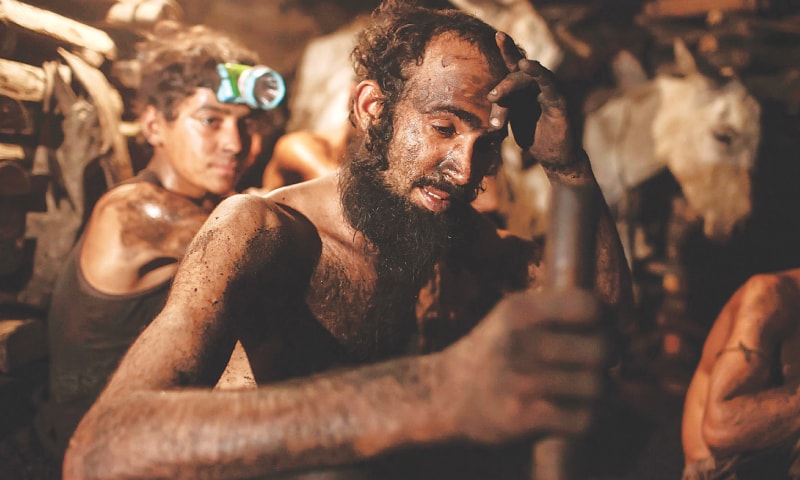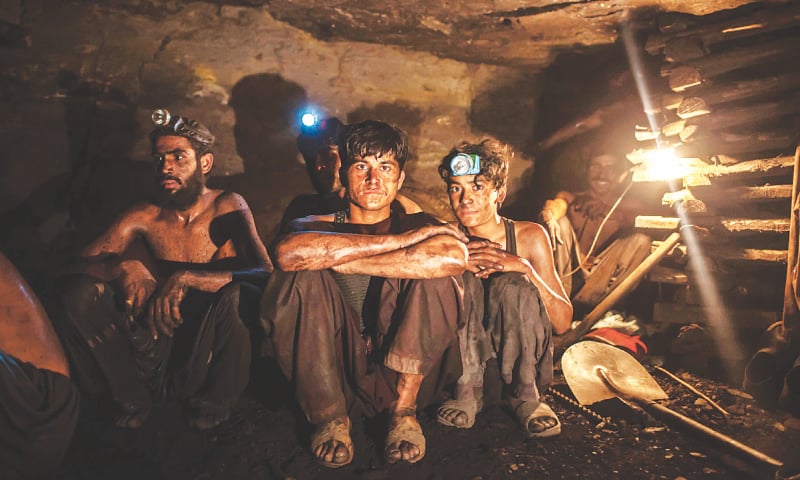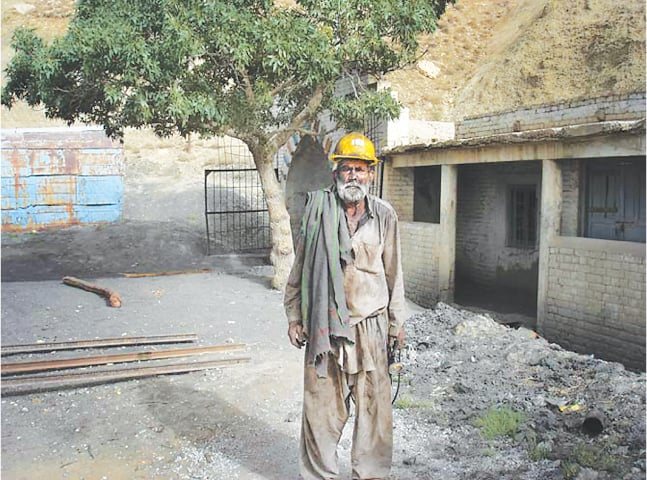
It was 2am, on May 7, in the village of Shalmano. Seven dead bodies had just arrived in the area located in Shangla district in Khyber Pakhtunkhwa. “My heart skipped a beat as soon as the ambulances opened their rear doors. Before I knew it I fell unconscious,” describes Umar Ali, a 22-year old coal miner who works in Machh, Balochistan. The mine he works in is one of 147 belonging to the Indus Coal Mines company.
Since that fateful day, Ali (on a two-month break from work) has been unable to eat heartily and his mother refuses to let him return to work.
In the first week of May this year, 23 men died and another 19 were injured in two mine-related accidents, according to the Pakistan Central Mines Labour Federation (PCMLF). The dead included the seven men from Ali’s village.
The loss of lives in recent coal-mining accidents brings to light some harsh realities
“We’re still in the fifth month of the year, and already so many men have died. The numbers keep rising each year,” says Mohammad Sultan Khan, secretary general of the PCMLF, a labour rights watchdog while talking to Eos over the phone from Quetta. A month back, in April, 21 miners had died and 47 were injured. Between January 2010 and March 2016, over 280 miners lost their lives in mining accidents in Pakistan, according to Sultan Khan. He fears that the number could be much higher as many deaths remain unreported with the coal fields situated in mountainous and inaccessible areas.
In one mine, there was an explosion due to build-up of methane gas and in the other, a mudslide had trapped, killed and injured several miners. Labour rights activists say these accidents are common due to poor enforcement of safety regulations.
“The roads are terrible, making speedy evacuation impossible in case of serious injury when time is of the essence,” says Sultan Khan. In addition, he says, workers are not provided proper equipment to check gas pressure. Often explosives for blasting rocks are improperly used. Caving in of mines is also a common occurrence.
THE WEAKEST LINK: THE COALMINER
In the entire process of coal extraction, the only consideration is how much money can be made by spending least on the most important link in the chain — the workers.

According to Ali, most workers suffer from respiratory problems such as asthma with bouts of cough — a regular background noise they soon get used to. “They come young and healthy and if they do not suffer an injury, they usually waste away in a few years, having contracted tuberculosis or Hepatitis B and C,” says Sultan Khan.
A 2013 study, carried out by the Department of Community Medicine, Pak International Medical College in Peshawar, on 400 miners in Cherat in Nowshera district, found 71 percent of miners suffering from respiratory health issues, whilst 49.5 percent had pneumoconiosis — a disease of the lungs due to inhalation of dust, characterised by inflammation, coughing and fibrosis.
INTO THE BELLY OF EARTH
Most coalminers are aware of the risk they are taking when they opt to go into this kind of work. In olden times, miners would carry a caged canary inside the pit and if the bird died, it was a signal to the workers to exit the mine immediately as the gases had reached toxic levels.
Journeying airless into the deep, dark recesses of the earth to dig out the black gold, using antiquated tools, can mean inhaling not just soot but toxic gases, being at risk of gas explosions, fires and even cave-ins, while hauling coal.
However, hauling coal is the easier part. At one time, Ali had to haul up dead bodies of co-workers. “That was the first time I blacked out,” he says.

According to Sultan Khan, it is always the co-workers who bring up the injured and the dead, never the rescue teams the government sends in the event of an accident. “The rescuers would never dare go so deep inside the mines. That is why I always say that coal miners should be given professional training in rescue work, but who listens!” he says.
PAKISTAN’S COAL RESERVES
The coal reserves of Pakistan are estimated at more than 185 billion tonnes. Nearly four million tonnes of coal is extracted annually, most of which is consumed by cement factories and brick-making kilns and for domestic use and very little for power generation. Another five million tonnes is imported from South Africa, Malaysia and Australia and is mainly used for power generation.
In Sindh, coal has been found in Thar, Lakhra, Sandra Jherruck, Meting-Jhimpir, Indus East and Badin; in the Sor Range/Degari, Khost, Mach (Bolan) and Duki in Balochistan; the Salt Range and Makarwal in Punjab; Cherat and Hangu in Khyber Pakhtunkhwa, and in Kotli in Kashmir. The country is littered with thousands of coal mines but only a few are registered. In Punjab, according to mining groups, there are 2,600 registered mines.

The mines are mostly owned by the state-run Pakistan Mineral Development Corporation, which is under the administrative control of the Ministry of Petroleum and Natural Resources. But most mines are leased out to private contractors.
While no surveys have been carried out in Balochistan, Sultan Khan estimates there could be up to 450 coal mines in the province. The reason for the lack of data is because there is no central registry.
“The mountains are leased out to individuals who then give it to operators, who hire supervisors to extract coal,” says Sultan Khan.
In several cases, the Balochistan chieftains have leased out the land as “political bribe”, says Karamat Ali, executive director of Pakistan Institute of Labour Education and Research (Piler).
BALOCHISTAN MINES BUT KP MINERS
Interestingly, a majority of mineworkers in Balochistan come from Khyber Pakhtunkhwa — particularly from Swat and Dir. Sultan Khan estimates that they form 87 percent of the workforce, with just 10 percent from Balochistan itself. “Most Pashtuns from Khyber Pakhtunkhwa have always done hard labour; on the other hand, the Pashtuns from Balochistan have been businessmen.”
Overall, he says, there are nearly 300,000 workers employed in minerals mines (including salt, chrome, copper, gypsum, marble and gold) across Pakistan out of which 200,000 alone work in coal mines. Of these, he estimates, about 125,000 to 150,000 are employed in Balochistan.
It is the money that lures them to the mines.
“Otherwise,” points out Ali, “who in their right mind would want to leave this heavenly place — lush forest, waterfalls and streams everywhere and weather to die for — and go to that godforsaken place which is dusty and barren?” A father of three, the young man has been working in coal mines since he was 15.

“I earn more in the six to seven months at the mines than I would ever be able to earn in a year,” he says. He works a 12-hour shift daily, sometimes going as deep as 6,000 feet for which he brings back 130,000 rupees.
“When I return to my village, the first few days are spent paying off the medical store, the grocer and the woodcutter,” he says.
Working in coalfields in Balochistan presents a stark and humdrum life. “We live in tents. Our meals consist of either a potato curry or lentils. On Thursdays we eat a meat dish and Friday is our day off when we wash our clothes, clean ourselves up — some may even head to a nearby town,” says Ali. “During break from work, it is music that keeps us entertained but only if someone among us with a mullah mindset has no objection!” he adds with a laugh.
“Poverty [among miners] is endemic; very few are educated and there is no [other] employment opportunity here for the men but they earn good money,” says 55-year-old Gulshah Khan, who worked as a driver in Islamabad for two decades and is now living a retired life earning from investments made in the mining industry.
In his village of Zarra, neighbouring Ali’s village, 14 men died in the two accidents. Seven were from the same family. Among the dead were two neighbours — Abdullah, 22 and his younger brother, 18-year-old Abdul Haq — who were miners in Marwar district in Balochistan.
“Their father also died from an accident in the same mine, when they were very young,” recalls Alibash Khan, a social worker, based in Shangla, who knew the boys. “Abdullah was to get married in June. It was heartbreaking to see all the preparation his mother had done for the upcoming wedding.”
END THE CONTRACT SYSTEM
“We do not have a good track record with safety issues of miners,” said Sultan Khan. “Unless the contracting system ends [and] labourers are registered with the Employees Old-age Benefit Institution [EOBI] [so they can avail benefits], we do not see any improvement in the plight of the workers,” he says. Moreover, inspections do not take place regularly under the supervision of private contractors. Even those working in the ship-breaking industry (well known as a hazardous workplace) are better off. “And that is not saying too much!” Sultan Khan continues. “If there is a fire on the ship, the workers either have to jump in the water and drown or get burned!” he explains. “In the case of those who are injured in a mine accident, some lose their limbs, some even their mind, but the contractors see no reason to come forward to pay compensation or hospitalisation [fees].”
SINDH MINE WORKERS BETTER OFF THAN BALOCHISTAN’S
“The mines in Balochistan are no less than death knells for workers,” says Qamoos Gul Khattak, secretary general of the National Labour Federation (NLF).
“You may find several mineworkers’ unions across Pakistan but all are headed by contractors. In such a situation, how will the voice of the workers in coal mines be heard?” he asks. He considers one of the biggest reasons for the deplorable plight of mine workers in Balochistan is that the province has the worst track record for health and safety of workers.
Khattak says that Sindh was the only province which had a union for miners in the true sense.
“This is absolutely correct!” concedes Sultan Khan, adding, “Balochistan trade unionists were fighting on many fronts. The topography [mines lie in very remote areas] makes access impossible, the law and order situation is almost non-existent and the feudal lords are both politicians and mine-owners making it most difficult to hold them responsible.”
In contrast, Khattak points out, “Mine workers in Sindh get an annual pay raise, an annual bonus, paid leave, a reward of 3,000 rupees on every Eid and healthcare is completely free even if it means expensive heart surgery.” If a worker is injured and unable to continue work, he is paid 5,250 rupees per month till his death. In case of an accident, the compensation is 600,000 rupees and another 100,000 rupees for transportation of the dead body and burial of the deceased. There is also proper housing and playgrounds for them.
NEED TO REVIEW AGE-OLD LEGISLATION
Pakistan has four national level laws related to health, safety and welfare of workers engaged in mining and quarrying: the Mines Act 1923, Mines Maternity Benefits Act 1941, Coal Mines (Fixation of Rates and Wages) Ordinance 1960, and the Excise Duty on Mineral (Labour) Welfare Act 1967. Under the existing laws and the general atmosphere of apathy, the owners and authorities care little about enforcement of safety clauses. “Examination of the four national level laws relating to health, safety and welfare of workers shows that these haven’t been reviewed after the 18th Amendment to conform to the ILO conventions of 1995 and later to the 2006 ILO code,” explains Huzaima Ikram, a senior advocate.
According to Sultan Khan, the Mines Act 1923 is a very comprehensive one, but does not penalise or hold anyone responsible in case of an accident.
“Coal extraction in developing economies like Pakistan comes at a great human cost because coal is cheaper and it exists aplenty,” Zeenat Hisam, senior researcher, having worked on labour rights for over two decades, tells Eos.
In a recent op-ed in daily Dawn, Hisam writes: “Pakistan has yet to legislate on and effectively enforce a modern mining law protecting the rights of all stakeholders including workers.”
Ikram says that the main reason for not updating the British-era mining laws is apathy on the part of legislators sitting in assemblies and the “ineffectiveness” of labour unions. In addition, there is no debate on this vital issue in the media which becomes active only in the event of a catastrophe. “Even then, they don’t open up discourse on the inadequacy of law and rules,” she points out.
According to Ikram, there is an urgent need for all provinces to re-enact the national level laws. However, she points out that, in a recent case, the Supreme Court held that although labour matters stand devolved to provinces, if more than one province is involved, then the labour laws as enacted by the National Assembly will prevail and provincial law will have to yield.
Published in Dawn, EOS, June 3rd, 2018













































